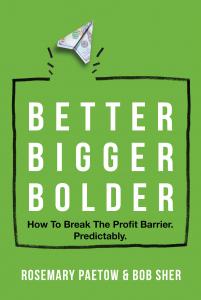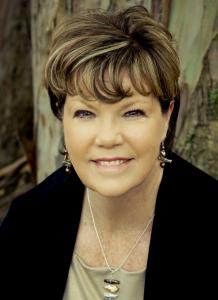CARLSBAD, CA, UNITED STATES, August 8, 2025 /EINPresswire.com/ — Most business owners believe that adding sales is the most precise way to grow a business. A new book advises that leaders also need to enhance customer service and team building to avoid specific blunders if they want to achieve predictable profitability.
“We studied the approach of highly successful CEOs whose companies consistently produced the sales and profits they desired,” says Rosemary Paetow, founder and president of Think inStrategy. In their new book, Better Bigger Bolder: How To Break The Profit Barrier. Predictably. (2025, Indie Books International), she and co-author Bob Sher explain steps to transition a business into a more profitable enterprise by focusing on where and why to re-ignite the company.
The book outlines a system for predictable profitability that uses the framework that all businesses are built upon to assess where to focus first. The system consists of the following four key elements:
– Foundation Infrastructure. This element focuses on strengthening and stabilizing the platform that enables consistent growth. Start here if you’re experiencing staff or client churn.
– Leadership Mindset. This element focuses on delivering the kind of feedback that improves performance. When culture, feedback, and rewards are aligned with what truly matters to the business, consistent execution is achieved. Start here if you have inconsistent revenue growth.
– Profit Lens. This element focuses on thinking in ways that deliver better decisions and ideas, all designed to increase profitability. By incorporating a tool called a “strategic lens,” staff can more quickly identify the right problem to solve and develop better solutions. This results in greater efficiency and profits. Start here if your net profit is too low.
– Growth Platform. This element focuses on the solution a company delivers to its customers that will best support predictable, consistent, and scalable growth (in sales). To fulfill the business’s true potential, define what the company does best. Start here after all other elements have been fine-tuned to generate rapid growth.
As a successful owner and manager of a mid-tier accounting software consulting firm for nine years and a former CPA from KPMG, Paetow now uses her skill set to evaluate businesses to determine alignment between messaging, strategy, and results. And then uses that learning to help CEOs become better leaders, make more informed decisions, and achieve bolder results.
Bob Sher is a business strategist with Think inStrategy. He has developed and led groundbreaking programs and served as executive for companies large and small. As the general manager of a $20 million manufacturing operation, Sher uses his experience of leading all phases of business, including sales, manufacturing and administration, to help business owners develop a better foundation upon which to grow.
Paetow and Sher contend that “Successful leaders avoid the ’sales plateau trap’ by building a better team that consistently produces predictable sales and profitability.”
When a company needs to transition, a term the authors use to describe a business phase in which an essential aspect of the business framework requires change, and how the leader thinks about how the business needs to adapt, the company’s initial design may be in flux.
Only 5% of entrepreneurs ever transition out of the “mom-and-pop” stage. That means nineteen out of twenty fail to emerge from the transition required to become a successful business.
Paetow and Sher suggest that mid-level companies with $3-$12 million in revenue typically take nine to twelve months of implementation to see noticeable changes in the top and bottom lines. Larger companies will see changes in six months or less. After that, achieving a 25 to 30 percent year-over-year growth is possible.
“Consistent, reliable growth measured in profitability and sales (we call that predictable profitable growth) allows a company to plan and earmark resources for expansion,” the authors state.
This creates a foundation upon which great things can happen and resolves the issue of determining what can be cut and what can be kept.
“In our consulting practice, we have seen many CEOs trying to squeeze every last ounce of work from their staff,” they caution. “When the staff push back, either through poor morale, absenteeism, or turnover, the CEO thinks, ‘my people could be better.’”
Paetow and Sher encourage a shift away from that thinking because it seems to breed increasing problems internally and externally. They recommend filling the company with people who think outside the box. This helps the enterprise to improve and eliminate the noise of those squeaking wheels, which demand precious attention with unimportant wants and needs.
About Indie Books International:
Indie Books International serves as an independent publishing alternative for experts and authorities to help create impact and influence.
Henry DeVries
Indie Books International
email us here
Legal Disclaimer:
EIN Presswire provides this news content “as is” without warranty of any kind. We do not accept any responsibility or liability
for the accuracy, content, images, videos, licenses, completeness, legality, or reliability of the information contained in this
article. If you have any complaints or copyright issues related to this article, kindly contact the author above.
![]()



